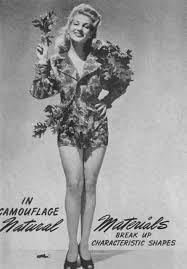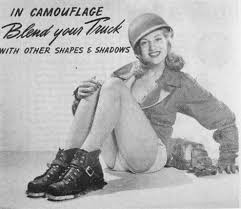More camo


“Camo Day” photos (more)
A second collection of odds and ends from the camouflaged world (part one is here, although you can likely scroll down the page a little to see it).
First up is the popularity in American secondary schools of “Camo Day,” where students and teachers dress appropriately [inset left]. Any Camo Day googling will quickly uncover a story on the Spurger [Texas] school that was flummoxed by a parent’s worry on the effect of a school tradition similar to Sadie Hawkins Day (where girls take the initiative in asking out boys): at Spurger, though, the boys often wore skirts or dresses for their celebration, raising a concern that the practice might lead to more widespread homosexuality. The school district cancelled the rite last year, replacing it with the manlier wearing of the ’flage.

In the late 1970s, French architect and artist Émile Aillaud imposed a camouflage pattern on seventeen high-rise buildings—the Cloud Towers [“Tours Nuages”], found in the Paris suburbs at Nanterre.

Scottish artist Ian Hamilton Finlay has long employed camouflage in works investigating Western pastoralism and the theme of death in arcadia.

Reprinted here: several anecdotes from Patrick Wright’s review of DPM: Disruptive Pattern Material in the London Review of Books on the part of fine artists in the development of camouflage.
“I well remember at the beginning of the war,” Gertrude Stein wrote in 1938, “being with Picasso on the Boulevard Raspail when the first camouflaged truck passed. It was at night, we had heard of camouflage but we had not seen it and Picasso, amazed, looked at it and then cried out, yes it is we who made it, that is Cubism.” Stein went on to suggest that the entire First World War had been an exercise in Cubism. Hailing Picasso as the first to register an epoch-making change in the “composition” of the world, she concluded that a great convulsion had been necessary to awaken the masses to his discovery: “Wars are only a means of publicizing the thing already accomplished.”

Abbott Thayer (1849-1921), the “father of camouflage,” American portraitist and landscape artist, was well known for his “angel” paintings, in which he added feathery white wings to portraits of girls and young women. In 1915, the painter was due to meet army authorities in London in order to exhibit a prototype camouflaged garment for snipers. Thayer, who was suffering from nervous tension at the time and was probably also fed up with being mocked and derided, pulled out of the meeting at short notice, leaving John Singer Sargent to attend on his own. The British generals are said to have been horrified when Sargent opened Thayer’s valise. According to Richard Murray of the Smithsonian American Art Museum, the prototype garment resembled an old hunting jacket, trailing strips of coloured cloth and daubed with patches of colour that reflected Thayer’s interest in harlequin costumes. It’s not clear whether the British generals objected to the scruffiness, the disruptive coloration or the cowardice that some military traditionalists still believed was at the root of the camoufleur’s new systems of deception.





Chili Williams
WWII camo posters
The British artist Solomon J. Solomon (1860-1927) and his colleagues came up with a grass-threaded fishing net, which would, he claimed, quickly become the “universal camouflage” material for French as well as British troops. Assisted by a carefully chosen band of scene painters from Covent Garden and the Drury Lane Theatre, Solomon also produced steel-cored observation posts that resembled slender willow trees. Other effects were achieved with wire-netting, dyed raffia, papier-mâché and plaster of Paris, the last proving especially useful in the construction of dummy heads that could be pushed up over a trench parapet to tempt enemy snipers into revealing their positions. Later, he worked at the secret Elveden Explosives Area in Suffolk, devising schemes that would enable Britain’s new tanks—which would later be dubbed “Cubist slugs”—to blend into the landscape. Solomon was repeatedly frustrated by the attitudes of the military command. He was mockingly addressed as “Mr. Artist” when he visited GHQ in France, and felt blocked in his attempts to ascertain the terrain in which tanks were likely to be deployed. The trainee tank soldiers appear to have remembered his designs not so much as Cubist attempts to confound enemy observers, but as ludicrous “pink sunsets” that would soon disappear under the flying mud of the Western Front.

The camouflage sections had enjoyed moments of popular acclaim on the Home Front. During the war bond campaign, Trafalgar Square was briefly turned into a “camouflaged” village, and a shop in Hackney’s Mare Street drew considerable attention when decked out as a camouflaged trench.
Labels: visual-culture





































2 Comments:
Hi Bill, I also agree with the potential spammer above that this is a superb entry, really just amazing. It made me think of Guy Davenport's essays in its thoroughness, its sinuous associative movement from topic to topic, and those kernels of telling information that I won't forget. Stein's comment, as always, is particularly fine, and I'll have to use it; I mean, what if we were to think of most wars--perhaps World War II wouldn't qualify, but others, including the current Iraq War, would, as "a means of publicizing the thing already accomplished?" In the case of this war, it would be the bankruptcy not only of Saddam's regime, but also the utter failure of neoconservatism and preemptive war as viable doctrines, the hollowness of the current administration, and the inevitability, which Saddam's brutality artificially held off, of Shiite Islamist rule in Iraq. Just fascinating...thanks!
John,
I've never read Davenport; should I pick up The Geography of the Imagination or something else?
You're right about Stein's quote: good, smart, and useful, to be tucked away.
xo
Post a Comment
<< Home